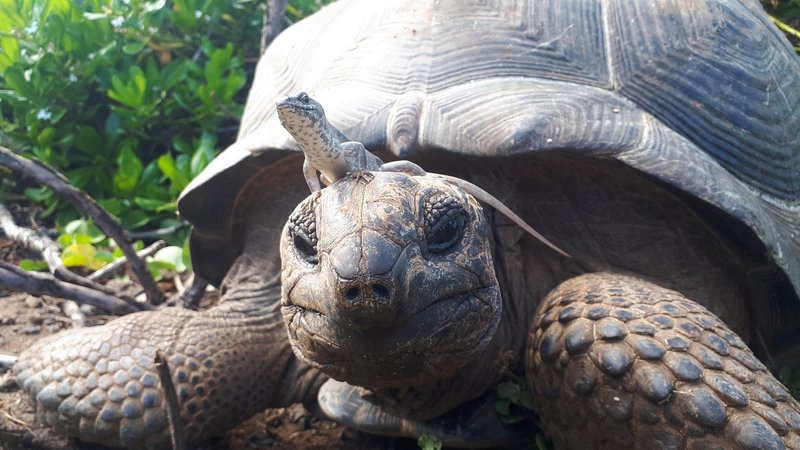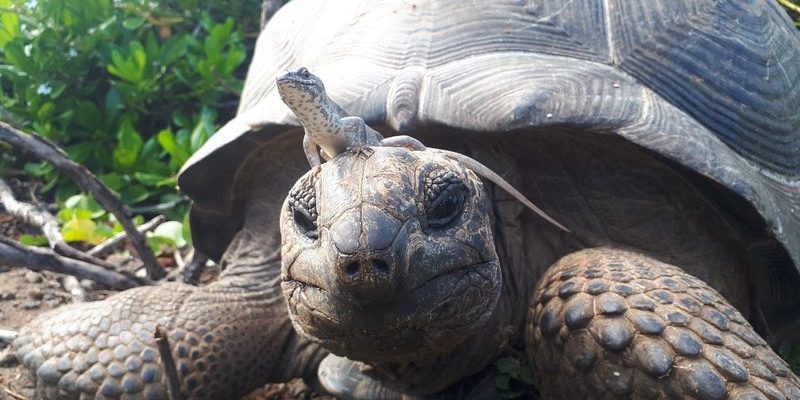
So, how does this ancient creature survive? It’s all about a mix of physical traits, clever behaviors, and a little bit of luck. The Aldabra giant tortoise has developed some fantastic survival strategies that not only help it cope with the harsh environment but flourish in it. Let’s dive into the unique features and strategies that make this tortoise a true survivor.
Physical Adaptations: Nature’s Design
One of the first things you’ll notice about the Aldabra giant tortoise is its impressive size. They can weigh upwards of 500 pounds and grow to about four feet long. This bulk isn’t just for show; it plays a key role in survival. Their size helps them store water and energy, especially during dry spells when food and water are scarce. Think of them as nature’s living water bottles.
Their thick, leathery skin also helps. This tough exterior protects them from the harsh sun and helps reduce water loss. While many animals need to constantly drink, the Aldabra giant tortoise can go for months without water. This ability to conserve moisture is crucial in their dry, hot environment. When it does rain, they can absorb water through their skin and drink from puddles.
Additionally, the tortoise has a unique shell shape. Unlike the dome-shaped shells of some other tortoise species, the Aldabra giant tortoise has a more flattened shell. This design allows it to maneuver through dense vegetation to find food and shelter more easily. It’s a perfect example of how adaptation can lead to a better chance at survival.
Dietary Choices: Master foragers
You might be wondering what these giants munch on while navigating their challenging home. The Aldabra giant tortoise has an herbivorous diet, primarily consisting of grasses, leaves, and fruits. What’s interesting is their ability to be selective eaters. They have a knack for finding plants that are high in moisture and nutrition, which helps them stay hydrated and energized.
During the dry season, finding food can be tough. But these tortoises are excellent foragers. They often travel long distances in search of food, using their keen sense of smell to locate plants. This persistence pays off because they can grow to a ripe old age, living over 100 years in some cases. Imagine having a keen sense of adventure just to find your next meal!
When food is abundant during the rainy season, they eat as much as they can. They need to pack on the calories to prepare for leaner times. This feasting strategy is like filling up a gas tank; when the reserves are full, they can manage their energy better during tough times.
Behavioral Strategies: The Power of Patience
Behavior also plays a massive role in how the Aldabra giant tortoise survives its environment. These tortoises are known for their slow and steady demeanor, which turns out to be a wise strategy. By moving slowly, they conserve energy, which is essential in their habitat where food can be unpredictable.
One fascinating behavior is their ability to bask in the sun. You might see them sprawled out, soaking in those rays. This not only helps them regulate their body temperature but also assists in digestion. The sun acts like a natural furnace for their bodies, helping them deal with colder nights.
When it comes to water, they’re savvy drinkers. The tortoises often take advantage of morning dew or rainwater collected on leaves. They know how to be in the right place at the right time, which is critical for survival. It’s a reminder of how patience and timing can lead to success in life.
Social Interactions: A Community Effort
While Aldabra giant tortoises might seem solitary creatures, they do engage in social interactions. They can often be found in small groups, especially during feeding. These groups can help them find food sources more efficiently, as they can share information about good feeding spots.
Interestingly, they communicate through body language and vocalizations. When they encounter one another, they might engage in displays by stretching their necks or making low grunting sounds. These interactions can help establish social hierarchies and ensure a balance within their community.
In times of danger, the group can also offer a sense of safety in numbers. If a predator approaches, the tortoises can retreat into their hard shells, a natural defense mechanism. This communal behavior enriches their survival strategy, making their community a vital asset.
Adapting to Climate Change: The Future of Survival
As climate change affects ecosystems worldwide, Aldabra giant tortoises are faced with new challenges. Rising sea levels and changes in weather patterns can impact their habitat and food sources. But here’s the thing: these tortoises are remarkably resilient. Scientists are observing how they adapt to the shifting environment, much like they have for centuries.
One way they are adapting is by adjusting their feeding habits. Researchers have noted that they are becoming more flexible in their diets, seeking out new plant varieties and exploring different foraging areas. This adaptability might help them face the challenges of a changing climate.
Conservation efforts are also in place to support these magnificent creatures. Protected reserves are crucial for their survival, as they provide a safe environment free from threats like habitat destruction and poaching. By taking care of their home, we give the Aldabra giant tortoise a fighting chance against the odds.
Final Thoughts: A Lesson in Resilience
The Aldabra giant tortoise is more than just a fascinating creature; it symbolizes resilience and adaptability. Living in harsh environments poses challenges, but through physical adaptations, clever behaviors, and community dynamics, these tortoises not only survive but thrive.
Their story serves as a reminder of the importance of conservation and understanding the delicate balance of ecosystems. Nature finds a way, and the Aldabra giant tortoise is a shining example of that tenacity. So, the next time you see a tortoise slowly strolling along, remember the incredible journey it has faced to survive against all odds.

